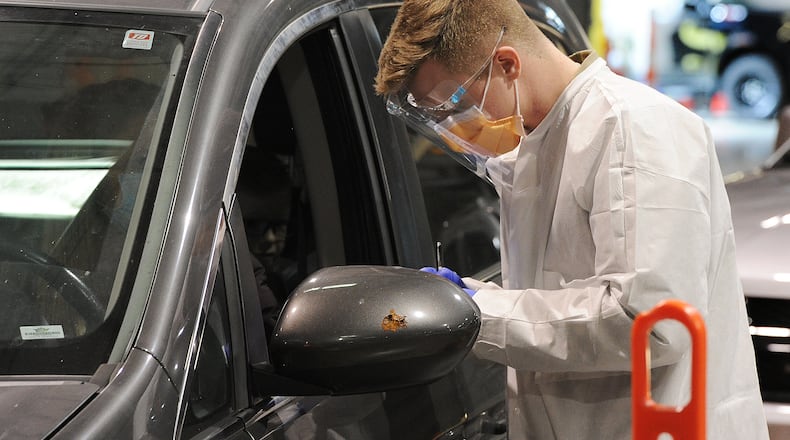But the growing popularity of home testing kits could mean a significant number of positive COVID-19 cases aren’t being reported to health officials and aren’t showing up in official case counts, which makes it difficult to know the true prevalence of the virus in the community.
Premier Health, which is one of the largest health care systems across southwest Ohio and the state, saw its COVID-19 testing peak on Nov. 24, 2020, when it performed 2,274 tests.
A year later, in November 2021, the health care system averaged about 635 tests per day. By February 2022, the average count fell to 362 tests per day.
Since May 1, Premier has been testing about 140 swabs for COVID-19 each day.
Robust surveillance, including reporting the results of at-home tests, is critical to inform health agencies’ understanding of the current spread of the virus, said Ken Gordon, a spokesman with the Ohio Department of Health.
“The overall volume of COVID-19 in our state and in specific areas lets Ohioans make informed decisions about what actions they should take to protect their health,” he said.
Experts also say people who test positive at home should contact their primary health care providers to make sure they take appropriate steps to manage and possibly confirm their illness and avoid transmission.
“Any positive test should be reported,” said Nate Bednar, director of community services with Miami County Public Health.
Some experts have pointed out that the true number of infections always has been an undercount because at least some people who contract the illness do not have any symptoms and do not seek testing.
Eye on testing
Credit: Jim Noelker
Credit: Jim Noelker
Confirmed COVID cases have declined, but the virus is still prevalent in the community, and Premier Health continues to see a significant positivity rate, said Nick Lair, the group’s system vice president of laboratory services.
“We always have to keep an eye on it,” he said. “We’re asking everybody to still be very mindful of the CDC guidelines, which is masking and/or six-foot distancing.”
In May, about 13.8% of tests conducted by Premier were positive for COVID, according to its data.
By comparison, the average positivity rate was about 9.7% in 2020.
Premier, along with its partners, still operates seven testing sites — down from about 11 earlier in the pandemic — which continue to serve many people who need negative tests for reasons like travel, work or school.
Testing sites are still widely available across the region, but at-home testing kits are becoming increasingly popular among people who develop COVID-19 symptoms or who may have exposed to the virus.
About one-fifth of people with COVID-19-like symptoms during the omicron wave used at-home tests to try to determine if they were infected, according to a CDC survey.
Credit: Jim Noelker
Credit: Jim Noelker
The tests — which officials say are quick, easy and pretty reliable — are available for sale at local pharmacies, and many health departments also have kits to distribute and so do other organizations, like libraries and schools in some areas.
The Ohio Department of Health has distributed seven million tests to its partners since January 2021, and home testing has become a substantial part of the testing that is taking place in the state, even though it is impossible to know how many home tests have been used or are available, Gordon said.
Community members also can order free COVID-19 test kits online through www.covid.gov/tests that will be sent to their homes.
The plethora of available testing is helping control the spread of COVID-19 because people can easily find out if they are positive early on, Lair said.
But Premier Health says the availability of home tests can result in a undercount of COVID cases in the community because people who test positive using the kits do not typically require further testing.
At-home kits come with instructions that say people who test positive for the virus should provide the results to their health care providers for public health reporting.
But it’s very likely that some people — possibly a significant number — aren’t doing that, some state and local experts say.
A survey conducted from late December and early January found that nearly one-third of people who tested positive at home did not follow-up with a test at their doctor’s office or a testing facility, which makes it likely their positive results were not captured in the official case data.
Testing sites generally still are required to report positive results, Gordon said, “but overall, testing data has become less useful as a measure of COVID-19 case burden and viral transmission in a community.”
Gordon said the state encourages Ohioans to check the Centers for Disease Control and Prevention’s COVID-19 Community Levels as a more accurate picture of virus transmission.
The measurement combines case counts with COVID-19 hospitalization data to determine how significant a threat the virus is to various communities, he said.
Some experts say the decline in officially reported COVID-19 cases gives some people the false idea that the virus isn’t a threat.
It is important that people who do self-tests report the results to their physicians, said Bednar, with Miami County Public Health.
Positive results can be reported to public health, he said, and “if it is a proctored home COVID test, they should follow the instructions on the test packaging and report using the app.”
Community members who test positive at home also should contact their primary care providers to find out if they need therapy, medical isolation and confirmatory or follow-up testing, said Deirdre Owsley, public health nurse in the communicable disease program at Greene County Public Health.
Owsley said Greene County residents who test positive for COVID at home should report the results to Greene County Public Health by calling 937-374-5638 or emailing cdrs@gcph.info.
Also, she said, “Any follow-up test if not already reported virtually through the home-test manufacturer can be reported by the provider and/or medical laboratory.”
Public Health — Dayton & Montgomery County encourages people who test positive at home to contact their doctors to determine if they should begin any treatment, such as Paxlovid, which should be started within five days of the onset of symptoms, Dan Suffoletto, a spokesman for the agency.
Public Health tries to contact people who tested positive when it receives notice of positivity from doctor’s offices and testing facilities, Suffoletto said.
Public health notifies the Ohio Department of Health when it has confirmed COVID cases.
But Suffoletto said the number of reported cases may not fully capture the true number of infections.
About the Author




